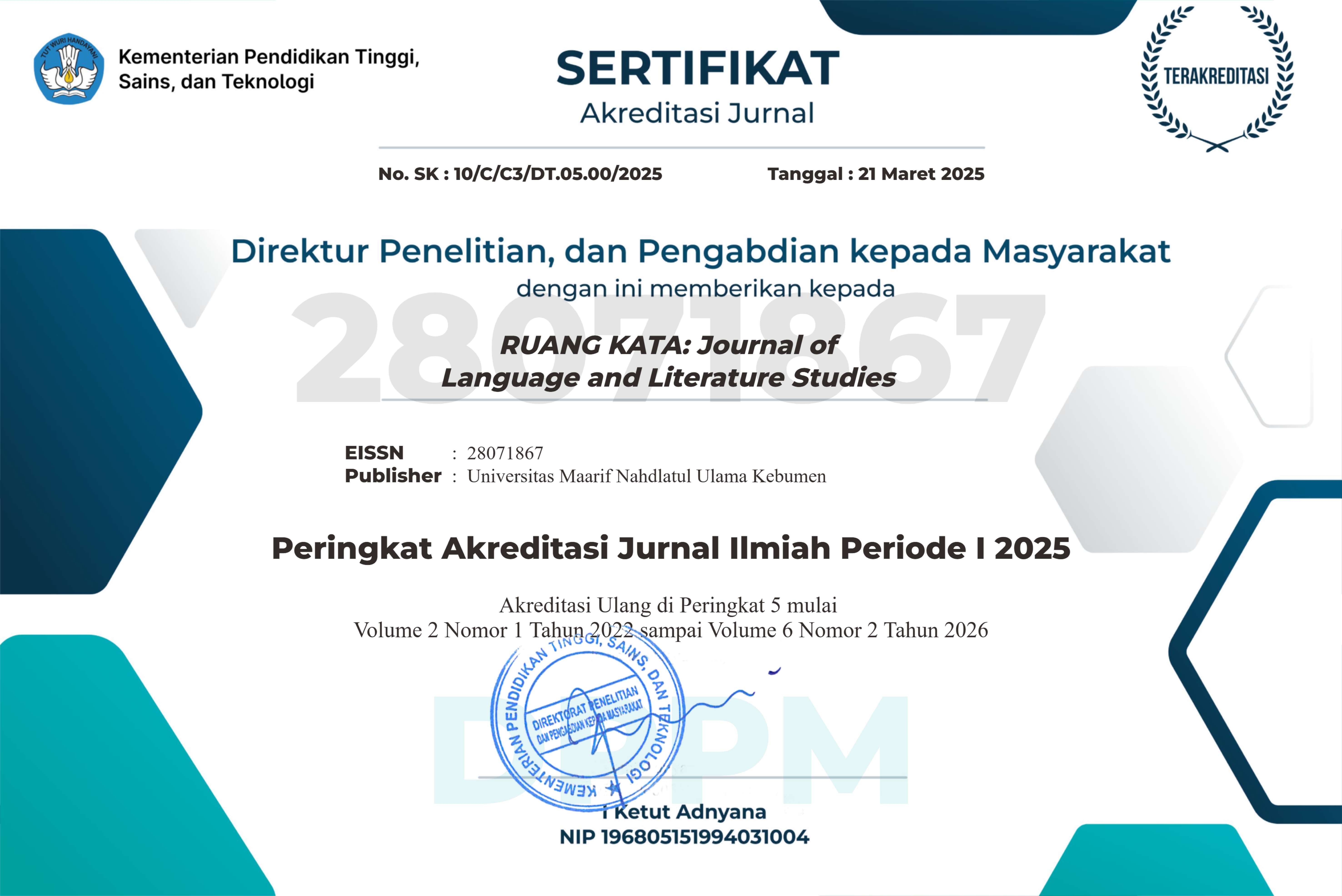Kekerabatan Bahasa Sumbawa dan Bahasa Madura: Kajian Linguistik Historis Komparatif
DOI:
https://doi.org/10.53863/jrk.v5i01.1643Keywords:
language kinship; lexicostatistics; glottochronology; Sumbawa language; Madurese languageAbstract
This study aims to examine the kinship of Sumbawa and Madurese languages with three main objectives, namely are 1) identifying the sound correspondence between Sumbawa and Madurese languages, 2) determining the level of kinship between the two languages based on lexicostatistical calculations, and 3) calculating the separation time between Sumbawa and Madurese languages. This research is a descriptive study that applied quantitative and qualitative approaches. The data sources used consist of 200 basic Swadesh vocabularies. Data collection for Sumbawa and Madurese languages was carried out using interview techniques with native speakers of both languages. Data analysis uses lexicostatistics and glottochronology based on comparative historical linguistic studies described by Crowley & Bowern (2010) and Keraf (1996). The results of the study show that the correspondence of consonant sounds between the two languages tends to remain constant and unchanged, but vowel sounds experience irregular changes. There are also strong sounds that are maintained such as the sounds of mata, lima and empat gloss. The level of kinship of Sumbawa and Madurese language is 39.3% and is included in the family category. In addition, the Sumbawa and Madurese languages are estimated to have originated from the same proto-language around 1,962 to 2,154 years ago
References
Bellwood, P. (2007). Prehistory of the Indo-Malaysian Archipelago (3 ed.). ANU E Press.
Crowley, T., & Bowern, C. (2010). An Introduction to Historical Linguistics (4 ed). Oxford University Press.
Dardanila, D. (2018). ‘Leksikostatistik Bahasa Karo dan Bahasa Gayo’. Talenta Conference Series Local Wisdom Social and Arts (Lwsa), 1(1), 185-191. https://doi.org/10.32734/lwsa.v1i1.161
Fitrah, Y., &Afriah, R. (2017). Kekerabatan Bahasa-Bahasa Etnis Melayu, Batak, Sunda, Bugis, dan Jawa di Provinsi Jambi: Sebuah Kajian Linguistik Historis Komparatif. Jurnal Titian, 1(2), 204–218.
Fernandez, I. Y. (2013). Linguistik Historis Komparatif: Teori, Metode, Pendekatan, dan Tekniknya. Universitas Gadjah Mada Press.
Ino, L. (2015). ‘Pemanfaatan Linguistik Historis Komparataif dalam Pemetaan Bahasa-bahasa Nusantara’. Retorika Jurnal Ilmu Bahasa, 1(2), 365. https://doi.org/10.22225/jr.1.2.41.365-378.
Keraf, G. (1996). Linguistik Bandingan Historis. PT Gramedia Pustaka Umum.
Maerina, R. (2019). ‘Distribusi dan Pemetaan Varian-varian Bahasa Madura di Kabupaten Sumbawa’. Mabasan, 1(1), 92-106. https://doi.org/10.26499/mab.v1i1.147
Mahriyuni., Pramuniati, I. and Maftuhah, R. (2023). ‘Lexicostatistics of Javanese and sasak Languages: Comparative Historical Linguistic Studies’. Mimbar Ilmu, 28(1), 124-130. https://doi.org/10.23887/mi.v28i1.59797
Mahsun. (2017). Metode Penelitian Bahasa: Tahapan, Strategi, Metode, dan Tekniknya. Rajagrapindo Persada.
Mulyani, S. (2007). Linguistik Historis Komparatif. Fakultas Bahasa dan Seni UNY.
Lailiyah, N. and Wijayanti, F. (2022). ‘Kekerabatan Bahasa Jawa, Bali dan Bima: Perspektif Linguistik Historis Komparatif’. Linguistik Indonesia, 40(2), 327-345. https://doi.org/10.26499/li.v40i2.308
Prasetyo, G. and Hendrokumoro, H. (2023). ‘Kekerabatan Bahasa Jawa dan Bahasa Batak Simalungun: Kajian Linguistik Historis Komparatif’. Deiksis, 15(3), 322. https://doi.org/10.30998/deiksis.v15i3.18362
Nothofer, B. (2016). Lokakarya dalam Seminar Internasional Migrasi Bahasa Austronesia. Badan Pengembangan dan Pembinaan Bahasa.
Salzner, R. (1960). Sprahen-Atlas des Indopazifishen Raumes. Wiesbaden: Otto Harasowitz.
Saussure, F. de. (1993). Pengantar Linguistik Umum (Diterjemahkan oleh Rahayu S. Hidayat). Gadjah Mada University Press.
Downloads
Published
How to Cite
Issue
Section
License
Copyright (c) 2025 Elya Febriani, Aliurridha Aliurridha, Rahmad Hidayat

This work is licensed under a Creative Commons Attribution-ShareAlike 4.0 International License.
Authors retain copyright and grant the journal right of first publication with the work simultaneously licensed under a Creative Commons Attribution-ShareAlike 4.0 International License that allows others to share the work with an acknowledgment of the work’s authorship and initial publication in this journal














